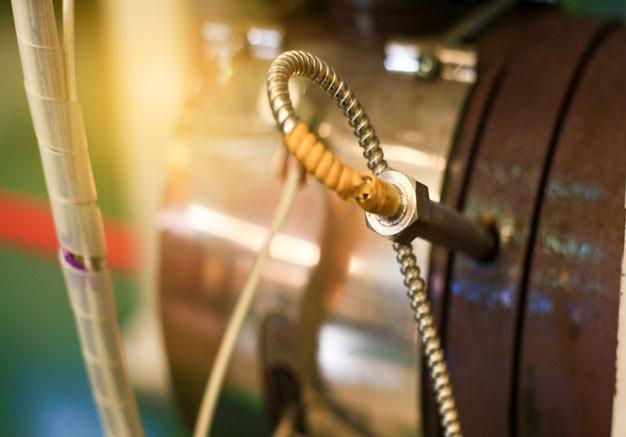
Process heaters, such as immersion heaters, use a range of sensor options to accurately measure and adjust the heat of a manufacturing process. If you’re a design engineer using the latest heating products, your process heater typically uses one of these three types of sensor:
- Resistance temperature detector, or RTD
- Thermocouple
- Thermistor
A thermocouple uses a metal junction of two different types of wire to measure the voltage. When the temperature changes at the measuring point, so does the electron density of each metal wire. This varying electron density is the voltage, which is measured at the connection point. These changes in voltage are read by the process controller, which uses a mathematical formula to calculate the relationship between voltage and heat and adjusts the temperature of the heater bundle as necessary to increase, decrease or maintain the ideal temperature for your industrial process.
RTDs operate on a similar principle and use resistance to determine temperature. These sensors are ideal for repeatable precision and more accurate assessment of your processing system.
Thermistors are ideal for rapid testing and accuracy in their measurement. Compare each of these sensor options to determine whether you need to replace your existing sensor option or consider a new way to measure your industrial heating operation. Watlow is a global supplier of thermal solutions and offers a complete line of thermocouple, RTD and thermistor sensors for your industrial application.
Signs of a damaged sensor
When you use a circulation or immersion heater for an industrial process, more precision heating is required. These complex heating systems require tighter control to maintain the necessary temperatures to achieve industry-leading performance. When a thermocouple or other sensor is damaged, your advanced thermal system may suffer as a result. If your processing output appears to have inconsistencies or compromised quality, use a secondary device to see if your sensor is measuring the correct temperature. If not, here are a few troubleshooting steps to try before replacing the sensor:
- Relocate the sensor
- Replace the sensor insulation
- Adjust the setpoint
- Install higher output cabling
Thermocouples and RTDs can become damaged and incorrectly read the current and temperature of your heating products. If you have unusual temperature fluctuations or temperature differences between multiple heater bundles, a replaced or repaired sensor can restore your heating process to optimal performance.
Removing a sensor
Learn how to remove a damaged thermocouple or RTD to keep your industrial process moving forward. Before removing or replacing your heater bundle, try these steps first to remove and replace your sensor.
Sheath thermocouples or RTDs commonly use hose clamps and compression fittings to secure the sensor in the optimal sensing location. Remove the clamp from the element leg and loosen the fitting inside the terminal enclosure to loosen the sensor assembly from your heating system.
Once the clamps and fittings are removed, pull the sensor through the terminal enclosure to remove it from the heater. Be careful not to damage the sensor while removing, as the issue may be in the wiring or other area rather than the sensor itself. Remove the compression fitting from the bottom of the terminal enclosure to completely remove the sensor from the heater bundle.
Inspect and test your thermocouple or RTD for voltage, resistance, continuity or other electrical issues. Look for signs of damage and replace a compromised heat sensor with the following steps.
Sensor replacement
Purchase a new sensor from Watlow that matches your heating products and industrial process requirements. In order to replace your sensor, you will need to replace the compression fittings, and clamps and ensure the wiring is still functional. You can also configure the ideal sensor using Watlow’s Visual Designer™ which provides visual feedback as you go.
New compression fittings will secure your new RTD or sheath thermocouple to the ideal measurement point. Install a new compression fitting at the bottom of the enclosure before inserting your new sensor.
OEMs and manufacturers need superior sensors for uncompromising quality and performance. Watlow process heating systems and sensors are industry leading solutions for your immersion, circulation or process heating needs.
Once the sensor is about 1/4-inch above the compression fitting at the enclosure bottom, secure it with clamps and compression fittings. A clamp prevents the sensor from moving out of the optimal sensing position. In many systems, the clamp worm gear should be tack welded. Never tack weld the heating element. The compression fitting should be tightened just past finger tight, around 1 and 1/4 turns past. Over tightening can damage the fitting.
The final step is to check the pressure of the compression fitting to be sure it is free from leaks. Design engineers need to then adjust the temperature controller, calibrate the new sensor and test it for accuracy.



